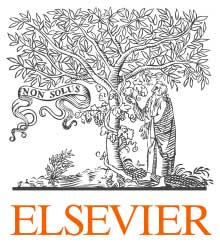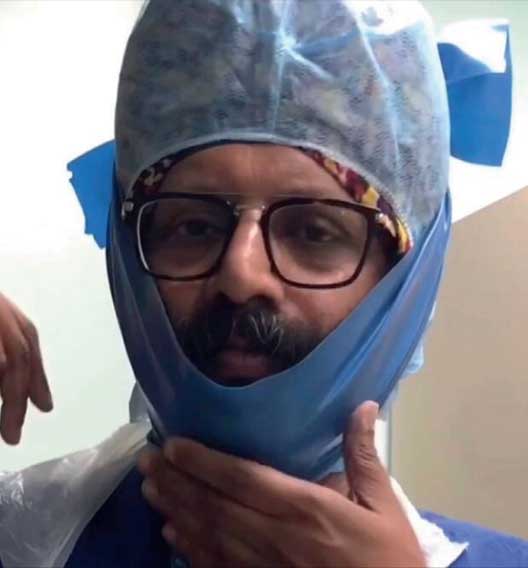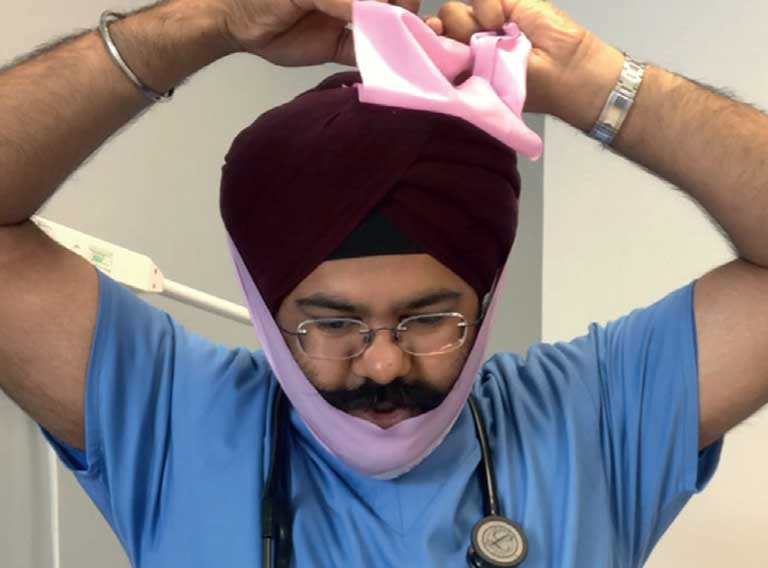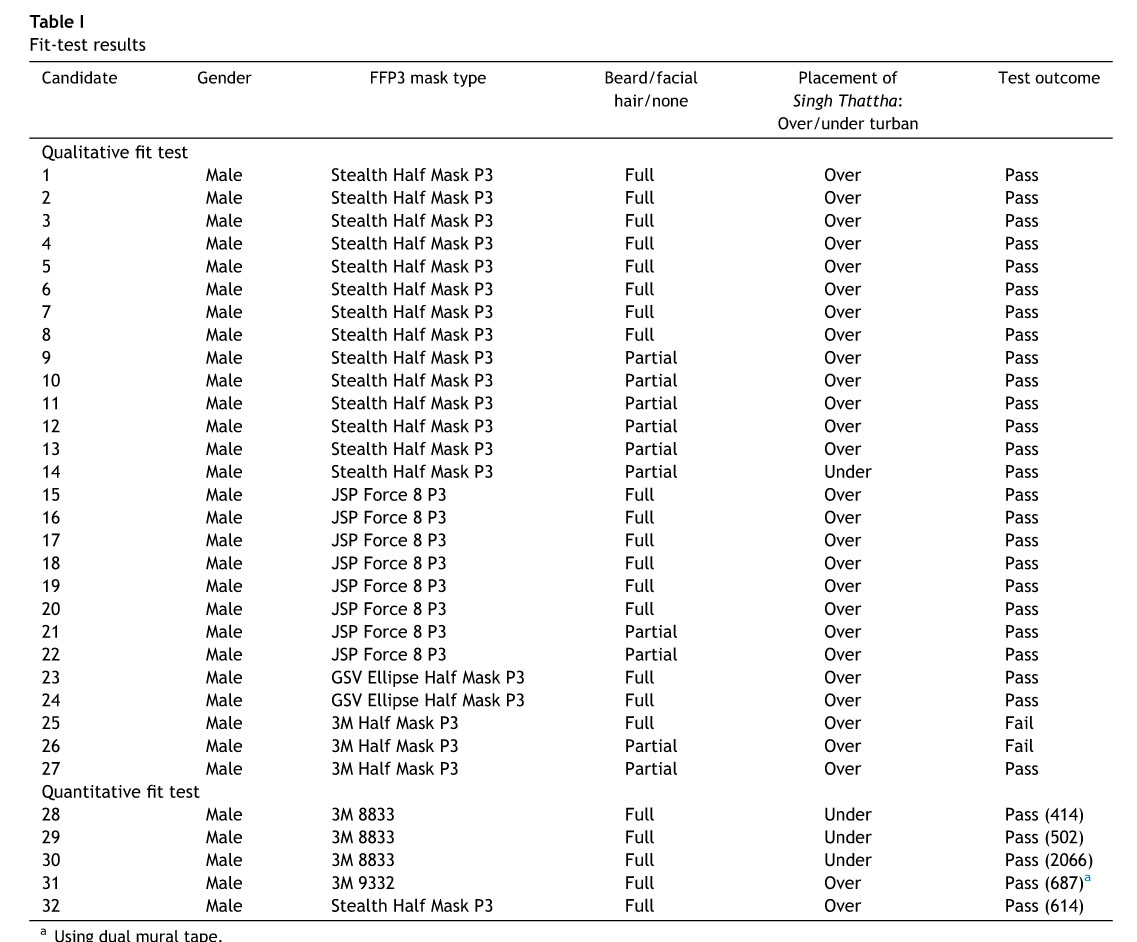British study commends Under-mask beard cover -Singh Thattha Technique
![COVID19 is still in the air and we need to expand our knowledge as much as we can. Global information and analytics company which enables institutions and professionals to advance health care and provide an open platform for the benefit of humanity has been providing relevant and pertinent information since January 2020 on its online resource centre on Elsevier Connect, relating to novel coronavirus COVID19. As the material is in the public domain, The World Sikh News presents the report […]](https://www.theworldsikhnews.com/wp-content/uploads/2020/12/beared-cover-slider-360x266.jpg)
COVID19 is still in the air and we need to expand our knowledge as much as we can. Global information and analytics company which enables institutions and professionals to advance health care and provide an open platform for the benefit of humanity has been providing relevant and pertinent information since January 2020 on its online resource centre on Elsevier Connect, relating to novel coronavirus COVID19. As the material is in the public domain, The World Sikh News presents the report of a study on the “innovative solution using an under-mask beard cover called Singh Thattha Technique for overcoming the beard factor to enable bearded individuals to wear a respirator mask.”
THE UNDER-MASK BEARD COVER (SINGH THATTHA TECHNIQUE) for donning respirator masks in COVID-19 patient care study has been carried out by R. Singh, H.S. Safri, S. Singh, B.S. Ubhi, G. Singh, G.S. Alag , G. Randhawa, S. Gill, in association with Sikh Doctors & Dentists Association, UK, Sikh Doctors Association, UK, British Sikh Dental Association, UK, British Sikh Doctors Organisation, UK, University of Bedfordshire, Bedford, UK.
Introduction
Tight-fitting respirator face masks such as N95 or filtering facepiece (FFP3) masks are considered to be the reference standard respiratory protective equipment (RPE) for healthcare workers (HCWs) working in aerosol-generating procedure (AGP) environments involving coronavirus disease 2019 (COVID-19) [1].
Optimal use of face masks depends on their tight seal with the wearer’s skin, assessed via RPE fit testing. Prior to working in AGP environments, HCWs must undergo and pass the mandatory RPE fit test, which is conducted either as a qualitative fit test (QFT) or as a quantitative fit test (QNFT). QFT is based on subjective assessment of face mask seal competency by detection of a test agent, usually sensed as a bitter or sweet taste, or smell by the wearer. QNFT gives an objective measure of face fit, by providing a numerical measure of the seal competency.
 Fit test is conducted by a certified fit tester, and passing it depends on type of respirator mask tested. In the event of shortage of successfully fit-tested face masks, HCWs must undergo repeat fit testing with other types of available face masks.
Fit test is conducted by a certified fit tester, and passing it depends on type of respirator mask tested. In the event of shortage of successfully fit-tested face masks, HCWs must undergo repeat fit testing with other types of available face masks.
Evidence suggests that facial hair reduces tight-fitting respirator face mask efficacy with worsening protection with longer facial hair [2]. Conventional fit testing in the presence of facial hair has been shown to have a high test-failure rate [3,4]. Hence, in line with the available evidence, face mask manufacturers’ guidance for fit testing recommends that wearers are clean-shaven to enable a good seal of FFP3 mask over their face covering the nose and the mouth.
This pilot study opens up possibilities for bearded HCWs looking to safely wear a tight-fitting respirator mask for whom shaving may not be a viable option.
Individuals unable to shave due to personal or religious reasons are recommended to use alternatives such as powered air-purifying respirators (PAPRs) [2]. However, these alternatives are expensive, limited in supply, and cumbersome to use [5]. They do not allow for fitting of surgical loupes. Dentists are unable to perform all the procedures in their repertoire. Redeployment to non-AGP areas incurs a loss of their skill-sets and need for retraining. Junior doctors have their training impacted with concerns for inadequate and prolonged training.

Therefore, this option of an alternative PPE may not be ideal for some individuals affected by the above-mentioned factors. There is no evidence in the literature to suggest why, instead of shaving, the facial hair factor cannot be overcome with an under-mask beard cover. The purpose of this study is to investigate an innovative potential solution called Singh Thattha technique, where an under-mask beard cover is used to overcome the facial hair factor for wearing a respirator mask by bearded individuals.
Methods
The technique of applying the under-mask beard cover to cover the beard over the chin and cheeks and tie the knot at the top of the head is called ‘Singh Thattha’ technique, and pioneered by a transplant surgeon in Manchester. Thattha is the colloquial term used for the beard cover, and the material used for the first case was fabric made of polyester-cotton blend.
Using this method the candidate ‘passed’ the Bitrex QFT Qualitative Fit Test (Macfarlan Smith, Edinburgh, UK) in one attempt wearing a 3M 8833 FFP3 mask. It was mentioned that the ‘pass’ was with a beard using a beard cover. The material was subsequently switched to a flat elastic rubber sheet (Pilates & Yoga Elastic band) for a better seal by the author (Figure 1a). The knot on top of the head could be either over the turban (Figure 1b) or over the inner head cloth (Figure 1c), depending on which gave the best fit with the FFP3 mask. We are reporting the outcomes of the Singh Thattha technique tested by QFT and QNFT.
Qualitative fit test
Singh Thattha technique was adopted by 27 male, bearded, Sikh dentists in the UK who subjected themselves to Bitrex QFT conducted by certified fit testers to existing industry standards set by the British Safety Industry Federation. Data was collected by the British Sikh Dentists Association and submitted to us for analysis.

Quantitative fit test
The technique was further subjected to robust review with a reputed fit tester through a QNFT session in Shrewsbury, UK. The QNFT method used was ‘Ambient Particle Counting’ using AccuFIT9000 S/N; Protocol: INDG 479; Pass Level: 100. Informed consent was obtained, and no participant was allergic to materials used. Participants included five male candidates from the bearded Sikh community.
Results
The results are summarized in Table I.

Outcomes of qualitative fit test
The Singh Thattha technique was used by 27 male bearded dentists, and the QFT pass rate was 25/27 (92.6%). Statistical analysis comparing the masks showed that the test pass was significantly greater using the stealth half-mask (14/14), JSP Force 8 P3 (8/8), GSV half mask P3 (2/2) as compared to the 3M Half Mask P3 (1/3) (P < 0.01, Fisher’s exact test).
Outcomes of the quantitative fit test
All five male candidates passed QNFT using the Singh Thattha technique. The first three candidates passed using 3M 8833 masks, with the knot of the under-mask Thattha tied on the top of the head covered by a cloth (Figures 1c, 2c). One of these candidates also passed using a 3M 1863 mask with an adhesive dual mural tape (DMT) in its upper inner lining, with the knot of the under-mask Thattha tied directly over the turban. The other two male candidates used FFP3 Stealth Half Masks and passed the QNFT with the under-mask Thattha tied directly over their turban (Figure 2b). Small numbers precluded a statistical analysis.
Discussion
The COVID-19 pandemic caused by the novel coronavirus known as severe acute respiratory syndrome coronavirus 2 (SARS-CoV-2) has resulted in a significant loss of lives and impacted resource utilization [1]. In their frontline duties, HCWs have suffered significant mortality. Healthcare providers have come under intense scrutiny to ensure that adequate and appropriate personal protective equipment (PPE) is provided for frontline workers.
The Singh Thattha technique to wear an FFP3 mask was pioneered in Manchester and was adopted and tested by a large number of bearded British Sikh dentists (25/27) who passed the QFT using certified fit testers. The technique was further tested using robust QNFT in a pilot study and all (5/5) fully bearded men passed the fit test.
Tight-fitting respirator masks, which depend on a seal of the mask with the wearer’s face, are considered the best protective RPE for HCWs working in AGP environments involving COVID-19. However, these are not suitable for bearded individuals as evidence has shown that beards will not allow for an optimal maskeface seal. Therefore, bearded individuals who are unable to shave due to personal reasons have to rely on alternative RPE such as expensive and cumbersome PAPRs, which may not be ideally suited for the work or training of some of these individuals e notably dentists and surgeons.
We are offering an innovative solution using an under-mask beard cover called Singh Thattha technique for overcoming the beard factor to enable bearded individuals to wear a respirator mask.
The Singh Thattha technique to wear an FFP3 mask was pioneered in Manchester and was adopted and tested by a large number of bearded British Sikh dentists (25/27) who passed the QFT using certified fit testers. The technique was further tested using robust QNFT in a pilot study and all (5/5) fully bearded men passed the fit test.
The relatively sturdier masks such as 3M 8833, Stealth Half Mask P3, JSP Force 8 P3, and GSV Ellipse Half Mask P3 were best-suited to achieve a competent seal using the Singh Thattha technique.
The beard-cover used (Pilates & Yoga Elastic band) is rubber material. During the fit test the different exercises used test that the silicone mask does not slip over the skin. In fact, the resistance of the rubber and silicone actually improved the fit in these exercises with the beard cover.
Whilst a limitation of this study remains small numbers of individuals tested using the under-beard cover technique, it provides encouraging results to pave the way for larger scale studies. The authors plan to conduct a follow-up study with the Singh Thattha technique involving larger numbers of bearded individuals given that the preliminary reports are quite encouraging.
Facial skin may sweat, but the Thattha material does not and is of an added advantage. Whereas other determinants of face-fit, such as face architecture and mask shapes, may be irreversible factors governing the outcome of the fit test, the beard factor could be overcome by an under-mask beard cover.
This pilot study opens up possibilities for bearded HCWs looking to safely wear a tight-fitting respirator mask for whom shaving may not be a viable option. In additional to cost-saving implications for healthcare providers, this solution minimizes potential risk of redeployment of some affected individuals who either have no access to alternative PPE, or if the available PPE are not conducive to performing for their specific job roles. Whilst a limitation of this study remains small numbers of individuals tested using the under-beard cover technique, it provides encouraging results to pave the way for larger scale studies. The authors plan to conduct a follow-up study with the Singh Thattha technique involving larger numbers of bearded individuals given that the preliminary reports are quite encouraging.
To summarize, the final arbiter of face-mask fit is a fit test-not the difference in the nuances of the chemistry between the ‘mask with face’ versus the ‘mask with beard cover’. Facial hair, albeit an accepted risk factor for face-mask leakage, can be overcome by using an under-mask beard cover.
Acknowledgements
British Sikh Dentists Association.
Conflict of interest statement Three of the authors were participants in the study. One of the authors is President of the Sikh Doctors and Dentists Association which funded the study, but he has no financial interest to declare.
Funding sources
Sikh Doctors & Dentists Association (UK).
References
[1] Public Health England. Guidance. Covid-19 personal protective equipment (PPE). Available at:
https://www.gov.uk/government/publications/wuhan-novel-coronavirus-infection-prevention-andcontrol/covid-19-personal-protective-equipment-ppe [last accessed September 2020].
[2] Health and Safety Executive. The effect of wearer stubble on the protection given by Filtering Facepieces Class 3 (FFO3) and Half Masks. HSE; 2015. https://www.hse.gov.uk/research/rrpdf/rr1052.pdf [last accessed September 2020].
[3] Sandaradura I, Goeman E, Pontivivo G, Fine E, Gray H, Kerr S, et al. A close shave? Performance of P2/N95 respirators in healthcare workers with facial hair: results of the BEARDS (BEnchmarking Adequate Respiratory DefenceS) study. J Hosp Infect 2020;104:529e33. https://doi.org/10.1016/j.jhin.2020.01.006.
[4] 3M Policy Document. Facial hair & respirator fit testing policy. Available at: https://multimedia.3m.com/mws/media/1682579O/facial-hair-and-respirator-fit-testing-policy-technical-bulletin.pdf [last accessed September 2020].
[5] Trivedy C, Mills I, Dhanoya O. The impact of the risk of COVID-19 on Black, Asian and Minority Ethnic (BAME) members of the UK dental profession. Br Dent J 2020;228:919e22.
 Print
Print

 109
109

